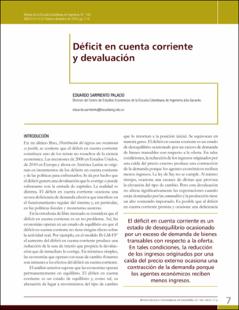Mostrar el registro sencillo del ítem
Déficit en cuenta corriente y devaluación
| dc.contributor.author | Sarmiento Palacio, Eduardo | |
| dc.date.accessioned | 2023-07-26T15:39:05Z | |
| dc.date.available | 2023-07-26T15:39:05Z | |
| dc.date.issued | 2015 | |
| dc.identifier.issn | 0121-5132 | spa |
| dc.identifier.uri | https://repositorio.escuelaing.edu.co/handle/001/2512 | |
| dc.description.abstract | En mi último libro, Distribución del ingreso con crecimiento es posible, se sostiene que el déficit en cuenta corriente constituye uno de los temas no resueltos de la ciencia económica. Las recesiones de 2008 en Estados Unidos, de 2010 en Europa y ahora en América Latina se originan en incrementos de los déficits en cuenta corriente y de las políticas para enfrentarlos. Se da por hecho que el déficit genera una devaluación que lo corrige o puede subsanarse con la entrada de capitales. La realidad es distinta. El déficit en cuenta corriente ocasiona una severa deficiencia de demanda efectiva que interfiere en el funcionamiento regular del sistema y, en particular, en las políticas fiscales y monetarias austeras. | spa |
| dc.description.abstract | In my last book, Income Distribution with Growth possible, it is argued that the current account deficit It is one of the unresolved issues in science. economic. The 2008 recessions in the United States, 2010 in Europe and now in Latin America originate from increases in current account deficits and the policies to deal with them. It is taken for granted that the deficit generates a devaluation that corrects it or can be corrected with the inflow of capital. The reality is different. The current account deficit causes a severe deficiency of effective demand that interferes in the regular operation of the system and, in particular, in austere fiscal and monetary policies. | eng |
| dc.format.extent | 9 páginas | spa |
| dc.format.mimetype | application/pdf | spa |
| dc.language.iso | spa | spa |
| dc.publisher | Universidad Escuela Colombiana de Ingeniería Julio Garavito | spa |
| dc.source | https://www.escuelaing.edu.co/es/investigacion-e-innovacion/editorial/ | spa |
| dc.title | Déficit en cuenta corriente y devaluación | spa |
| dc.type | Artículo de revista | spa |
| dc.type.version | info:eu-repo/semantics/publishedVersion | spa |
| oaire.accessrights | http://purl.org/coar/access_right/c_14cb | spa |
| oaire.version | http://purl.org/coar/version/c_970fb48d4fbd8a85 | spa |
| dc.contributor.researchgroup | Centro de estudios económicos | spa |
| dc.identifier.eissn | 0121-5132 | spa |
| dc.identifier.instname | Universidad Escuela Colombiana de Ingeniería | spa |
| dc.identifier.reponame | Repositorio digital | spa |
| dc.identifier.repourl | https://repositorio.escuelaing.edu.co/ | spa |
| dc.identifier.url | https://escuelaing.s3.amazonaws.com/production/documents/Revista_Escuela_Colombiana_de_Ingenier%C3%ADa_100.pdf?AWSAccessKeyId=AKIAWFY3NGTFD5OU3IGB&Signature=FNT8Y4hl89Nb%2F2E1eYfijjpMmuI%3D&Expires=1692746920 | |
| dc.publisher.place | Bogotá D.C. | spa |
| dc.relation.citationedition | No. 100 Octubre - Diciembre 2015 | spa |
| dc.relation.citationendpage | 16 | spa |
| dc.relation.citationissue | 100 | spa |
| dc.relation.citationstartpage | 7 | spa |
| dc.relation.indexed | N/A | spa |
| dc.relation.ispartofjournal | Revista De La Escuela Colombiana De Ingeniería | eng |
| dc.relation.references | Arrow, K. & Debrew, G. (1954). Existence of equilibrium for a competitive economics. Econométrica, 22. | spa |
| dc.relation.references | Baumol, W.J. (1960) Monetary and revalue theory. Review of Economic Studies | spa |
| dc.relation.references | Becker, G.S. & Baumol, W.J. (1952). The classical monetary theory: the outcome of the discussion. Economica, vol. 19, N.° 76. | spa |
| dc.relation.references | Clower, R.W. (1965). “The Keynesian counterrevolution”: A theoretical appraisal. En F.H. Hahn & F.P.R. Brechilig (eds.). The Theory of interest rates. Londres: Macmillan | spa |
| dc.relation.references | Dornbusch, R. (1976). “Expectations and exchange rale dynamics” journal of political economy (decembe). | spa |
| dc.relation.references | Keynes, J.M. (1936). The Genera l theory of employment, interest and money .Nueva York. | spa |
| dc.relation.references | Lange, O.1942). Say law: A restatement and criticism and O. Lange, studies in Mathematical Economics and Econometrics. Chicago University of Chicago Press | spa |
| dc.relation.references | Leijonhufoud, A. (1981). Information and coordination. Essays in macroeconomic theory. New York Oxford University Press. | spa |
| dc.relation.references | Mill, J. (1821). Elements of political economy. Londres. | spa |
| dc.relation.references | Mill, J.S., Essays on some unsettled questions of political economy (1844). Reprinted, Londres, 1948. | spa |
| dc.relation.references | Patinkin, D.P. (1965). Money, interest, and prices. Nueva York: Haper & Row, Publishers, New York. | spa |
| dc.relation.references | Ricardo, D. (1951-1952). Works and correspondence, 9 vols. P. Sraffa (ed). Cambridge. | spa |
| dc.relation.references | Sarmiento, E. (2002). El modelo propio. Bogotá: Grupo Editorial Norma - Editorial Escuela Colombiana de Ingeniería. | spa |
| dc.relation.references | Sarmiento, E. (2008). Economía y globalización. Bogotá: Grupo Editorial Norma. | spa |
| dc.relation.references | Sarmiento, E. (2014). Distribución del ingreso con crecimiento es posible. Editorial Escuela Colombiana de Ingeniería. | spa |
| dc.relation.references | Sarmiento, E. (julio-septiembre de 2015). Crecimiento desbalanceado y política industrial. Revista de la Escuela Colombiana de Ingeniería, N.° 199. | spa |
| dc.relation.references | Schumpeter, J.A. (1956). Money and the social products. International Economic Papers. | spa |
| dc.rights.accessrights | info:eu-repo/semantics/openAccess | spa |
| dc.subject.armarc | Recesiones | |
| dc.subject.armarc | Comercio exterior | |
| dc.subject.armarc | Inflación | |
| dc.subject.armarc | Demanda (teoría económica) | |
| dc.subject.armarc | Recessions | |
| dc.subject.armarc | Foreign trade | |
| dc.subject.armarc | Inflation | |
| dc.subject.armarc | Demand (economic theory) | |
| dc.subject.proposal | Déficit | spa |
| dc.type.coar | http://purl.org/coar/resource_type/c_6501 | spa |
| dc.type.content | Text | spa |
| dc.type.driver | info:eu-repo/semantics/article | spa |
Ficheros en el ítem
Este ítem aparece en la(s) siguiente(s) colección(ones)
-
AG - Centro de Estudios Económicos [184]
Clasificación: C - Convocatoria 2018










